- Lean Interview Questions
- Lean Manufacturing Tools
- Lean vs Six Sigma
- Six Sigma Interview Question and Answers
- What is Lean Management? - A Complete Tutorial
- What is Six Sigma Green Belt?
- What is Lean Six Sigma - The Definitive Guide
- Six Sigma Companies
- Six Sigma Techniques
- Six Sigma Methodology
- Six Sigma Projects and Use Cases
- Six Sigma VS Kaizen
We all know that quality is a thing that you cannot achieve overnight. Yes! It is a continuous as well as intelligent effort that improves the quality of products and services over time. Six Sigma is one of the powerful strategies increasingly used by many companies to enhance the quality of their products – no matter how big or small the companies are. It doesn't matter whether it is a product development project or a service sector – all of them use six sigma tools to overcome obstacles in ensuring quality. As a result, they could offer customers high-quality products and services.
It is essential to note that the obstacles can be business process variations. With the help of six sigma tools, you can eliminate the variations and drive improvements consistently.
In this blog, we will walk you through the two six sigma methodologies, the powerful six sigma tools, their benefits, and much more in a straightforward way.
| Table of Content: Six Sigma Tools |
What is Six Sigma?
Six Sigma is a well-defined, statistical-based, problem-solving approach with which you can find variations in business processes. In other words, you can find variations in the business progress. Not just finding the variations, six Sigma supports eliminating them totally.
Six Sigma is a principle-based business methodology that improves product quality to greater heights. It offers many robust analytical tools to identify variations, remove redundancy, and improve the efficiency of processes.
Know that Data is the lifeline of six sigma tools. The tools analyze data to identify variations at any stage, whether in the input, processing, or output stage.
All you need to understand about six sigma tools is that they minimize variations in processes and maximize efficiency through continuous improvement.
| If you want to enrich your career and become a professional in Six Sigma, then visit Mindmajix - a global online training platform: "Six Sigma Green Belt Training" This course will help you to achieve excellence in this domain. |
What are Six Sigma Tools?
Plenty of six sigma tools are used to define, measure, analyze, improve, and control processes.
Let’s discuss the mainly used six sigma tools in the following.
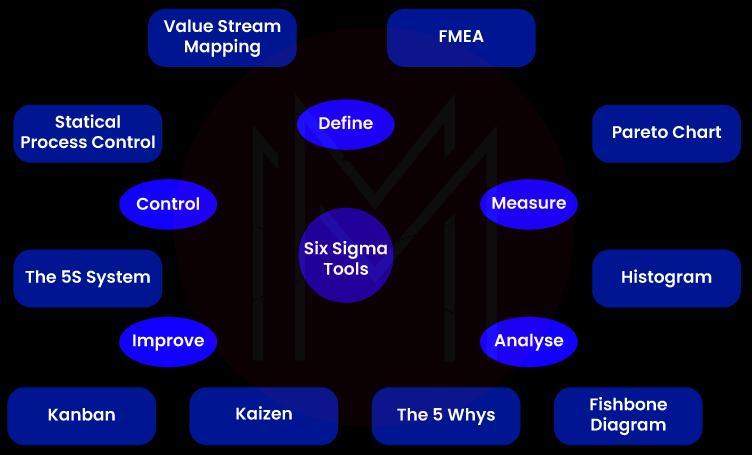
List of Top Six Sigma Tools
Tool #1. Value Stream Mapping
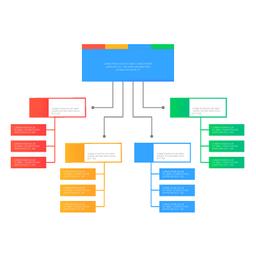 This is a six sigma tool that uses a flowchart to outline the information as well as materials required for process improvement. Every flowchart has three core elements: process map, information, and timeline. With this flowchart, we can clearly visualize information such as time, delays, error rate, etc. Overall, we can streamline process flow with the necessary information required by using this six sigma tool.
This is a six sigma tool that uses a flowchart to outline the information as well as materials required for process improvement. Every flowchart has three core elements: process map, information, and timeline. With this flowchart, we can clearly visualize information such as time, delays, error rate, etc. Overall, we can streamline process flow with the necessary information required by using this six sigma tool.
Tool #2. FMEA
 FMEA is the short form for Failure Modes and Effects Analysis. Proactiveness is the basic principle behind this six sigma tool. According to this method, you need to find potential failures in processes and implement corrective measures before any failure can happen. Besides, it is one of the cost-effective tools since it allows making corrections in processes before implementing them in a production environment.
FMEA is the short form for Failure Modes and Effects Analysis. Proactiveness is the basic principle behind this six sigma tool. According to this method, you need to find potential failures in processes and implement corrective measures before any failure can happen. Besides, it is one of the cost-effective tools since it allows making corrections in processes before implementing them in a production environment.
Tool #3. Pareto Chart
 It is the six sigma tool that proposes the 20-80 rule. The significant thing about this rule is that only 20 % of efforts will generate 80 % of output. This tool helps to find the crucial processes that significantly impact the result of the business or projects. This is because focusing on the crucial processes will help to improve overall performance.
It is the six sigma tool that proposes the 20-80 rule. The significant thing about this rule is that only 20 % of efforts will generate 80 % of output. This tool helps to find the crucial processes that significantly impact the result of the business or projects. This is because focusing on the crucial processes will help to improve overall performance.
Similarly, we can find the processes that create more errors than others. So we can control them immediately to optimize processes. In short, this tool encourages clever work rather than hard work.
Tool #4. Histogram
 In its basic form, it is the visual representation of the frequency distribution of data. With this six sigma tool, we can quickly identify the variations in a graph. Subsequently, we can locate where problems exist in processes so that we can rectify them with corrective measures. The significant thing in applying corrective measures is that we need to find the root causes accurately and then implement the measures. Only this approach will produce better results.
In its basic form, it is the visual representation of the frequency distribution of data. With this six sigma tool, we can quickly identify the variations in a graph. Subsequently, we can locate where problems exist in processes so that we can rectify them with corrective measures. The significant thing in applying corrective measures is that we need to find the root causes accurately and then implement the measures. Only this approach will produce better results.
Tool #5.The 5 Whys
 The basic principle behind this six sigma tool is asking ‘why’ five times repeatedly to dig out the root cause of a problem. This method helps to choose the most accurate solutions for problems. Mainly, you can solve complex problems efficiently and derive better solutions.
The basic principle behind this six sigma tool is asking ‘why’ five times repeatedly to dig out the root cause of a problem. This method helps to choose the most accurate solutions for problems. Mainly, you can solve complex problems efficiently and derive better solutions.
It is essential to note that although this method looks simple, the results are so powerful.
Tool #6. Fishbone Diagram
 It is the cause-and-effect visual tool. With this six sigma tool, you can find the root cause of problems. This tool binds mind mapping and brainstorming methods to determine the root cause of problems.
It is the cause-and-effect visual tool. With this six sigma tool, you can find the root cause of problems. This tool binds mind mapping and brainstorming methods to determine the root cause of problems.
Tool #7. Kanban
 Actually, Kanban means a graphic card. A Kanban board is usually made up of a series of graphic cards. Every Kanban board will have at least three vital parts: works completed, works in on-progress, and works to be completed. So, you can keep track of the work progress closely by using the tool. The main thing about this tool is that it draws limits for every process. As a whole, this six sigma tool encourages high-level focus and improves efficiency.
Actually, Kanban means a graphic card. A Kanban board is usually made up of a series of graphic cards. Every Kanban board will have at least three vital parts: works completed, works in on-progress, and works to be completed. So, you can keep track of the work progress closely by using the tool. The main thing about this tool is that it draws limits for every process. As a whole, this six sigma tool encourages high-level focus and improves efficiency.
Tool #8. Kaizen
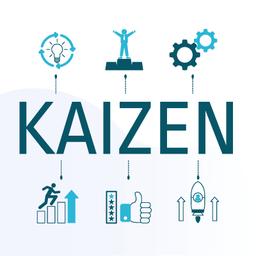 The basic principle behind this six sigma tool is continuous improvement. This tool encourages improvements in small increments, which will produce significant results positively. In the same way, this tool aims to reduce redundancy and increase efficiency. Besides, Kaizen improves collaboration since it encourages the active participation of people.
The basic principle behind this six sigma tool is continuous improvement. This tool encourages improvements in small increments, which will produce significant results positively. In the same way, this tool aims to reduce redundancy and increase efficiency. Besides, Kaizen improves collaboration since it encourages the active participation of people.
Tool #9.Statistical Process Control (SPC)
 This six sigma tool allows building control charts with which you can track the performance of improvements already applied to processes. With control charts, you can visualize and understand the progress of processes compared to the normal values.
This six sigma tool allows building control charts with which you can track the performance of improvements already applied to processes. With control charts, you can visualize and understand the progress of processes compared to the normal values.
In other words, this control chart tracks the progress of processes over time, which will help to identify the exact spot and degree of variations. So you can apply suitable corrective measures. Actually, these variations are known as special cause variations. Further, you need to identify the root cause for the variations and implement the corrective measures.
Tool #10.The 5S System
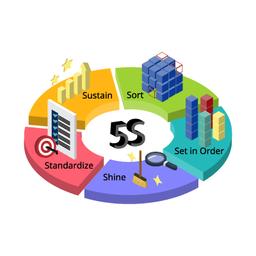 5S stands for Sort, Straighten, Shine, Standardise, and then Sustain. It is the six sigma tool that comes with a visual plan that is closely related to workstation optimization. Mainly, when you implement a new process, you need to modify your workstation in such a way that it simplifies implementing the new process. As a result, the work environment would become more feasible and conducive.
5S stands for Sort, Straighten, Shine, Standardise, and then Sustain. It is the six sigma tool that comes with a visual plan that is closely related to workstation optimization. Mainly, when you implement a new process, you need to modify your workstation in such a way that it simplifies implementing the new process. As a result, the work environment would become more feasible and conducive.
When it comes to software projects, you can delete unwanted files and folders, organize the needed files, standardize naming conventions, monitor the data flow, and so on – based on the 5S system.
Key Principles of Six Sigma
Essentially, six sigma tools are designed based on the following fundamental principles.

Six Sigma Methodologies
Know that there are two six sigma methodologies as follows
- DMAIC
- DMADC
Now, it's time to dig into what DMAIC is.
1. DMAIC
It is the short form of Define, Measure, Analyse, Improve, and Control. These are the stages involved in the DMAIC method. You can use this method to correct a process that is already live. In other words, you can use this method when a process doesn’t meet the specified values.
If you want to know what each stage does, move on to the following.
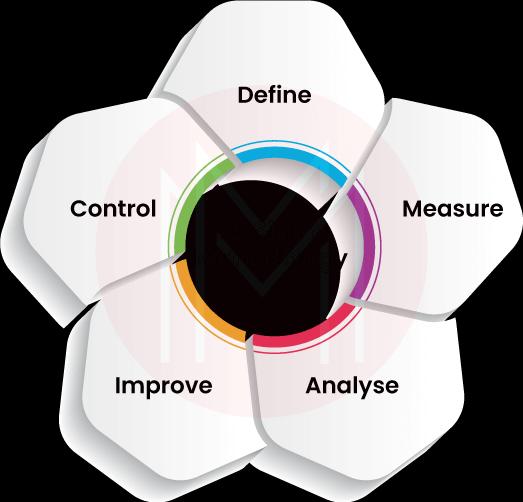
1. Define
First, you need to identify the quality goals based on customer expectations, desired values, industry standards, etc. Along with that, you need to prepare a problem statement, inputs as well as outputs of various processes, project scope, and other essential aspects.
2. Measure
This stage helps to understand the performance level of existing processes. To achieve this, you will measure all the parameters associated with the processes, such as cycle times, variance, inputs, outputs, etc. And with this, you can find the gap between the actual and target performance of the processes. It will allow you to take suitable corrective actions.
3. Analyse
In this stage, you will identify the root cause for the process variations. You will achieve this by using analytic methods such as regression analysis, 5 Whys, Fishbone diagram, and others.
4. Improve
It is one of the crucial and longest stages in the six sigma methodology. This stage includes creating as well as implementing solutions using brainstorming and other innovative practices. Before implementing solutions, you need to carefully test and optimize them to improve the efficiency of processes.
5. Control
It is the final stage in the six sigma process. In a way, it is a sustainability stage used to continue the performance of processes. This stage includes tracking processes, empowering people, updating documentation, reinforcing solutions, and so on.
2. DMADV
It is the short form of Define, Measure, Analyse, Design, and then Validate. This method can create a new process and validate its efficiency.
Related Artice: Six Sigma Interview Questions and Answers
Why are Six Sigma tools so Important?
Before diving into the concepts of six sigma tools, we will know why it has gained much importance. There are plenty of reasons for that.
At a glance, we will look at some of the reasons below:
- Six sigma tools drive transformation in business processes slowly and positively and enhance productivity to high levels.
- With six sigma tools, you can minimize the frequency of maintenance in a production environment
- They help to prevent IT threats. As a result, you can reduce downtime to a minimum.
- Ultimately, six sigma tools provide cost-effectiveness, optimized use of resources, improved cycle time, reliable products, and many more.
Benefits of Six Sigma Tools
When it comes to the benefits of six sigma tools, we can categorize them into three levels – employee, enterprise, and customer.
Let’s now look at them as follows:
1. Employee Level
Six sigma tools encourage the participation of employees at all levels, resulting in improved collaboration among employees. Appreciation and feedback from team members will definitely support employees in improving their performance over time.
2. Enterprise Level
Cost-effectiveness is the prime benefit of six sigma tools. The efficient process flows, efficient use of resources, decreased lead times, etc., will reduce costs and enhance performance. Simply put, six sigma tools boost productivity and boom income undoubtedly.
3. Customer Level
Six sigma tools offer high customer satisfaction and retention rates. This is because customers receive high-quality products and services.
What are the Six Sigma Certification Levels?
You can attain six sigma certification in various levels – from basic to higher. In other words, we can say – from white belt to master black belt.
Are you interested to know why this comparison?
It is simple. As people earn white belts to black belts based on their competency in martial arts, the learners of six Sigma gradually achieve certifications from basics to a higher level.
Let’s see the certifications and their objectives as follows:
1. White Belt
It is the basic level six sigma certification. White belt holders know the fundamentals of six sigma concepts. So they can actively participate in quality control and other six sigma projects.
2. Yellow Belt
The yellow belt holders can track and evaluate the progress of six sigma implementations. Not only that, they can make a solid contribution to the six sigma team.
3. Green Belt
Green belt holders can implement sig sigma methodologies to improve processes confidently. Besides, they will handle statistical six sigma tools effortlessly.
4. Black Belt
Black belt holders are the leaders who can monitor six sigma methodologies and implement changes in processes on a large scale. It means they can easily manage complex projects. No wonder they can mentor green and yellow belt holders.
5. Master Black Belt
It is the highest level certification. The master black belt holders will guide black belt holders. They will usually be experts in six sigma tools such as statistical analysis, regression analysis, strategic planning, process optimization, factorial experiments, etc.
Related Article: What is the Six Sigma Green Belt?
Conclusion
Now it’s time to wrap! Be it a business process or development project based on the 5S system – six sigma tools play a pivotal role in optimizing them. Keep in mind six sigma tools help to identify variations in processes from their actual values. It will allow you to make a suitable course of action, streamline the processes, and improve the quality of products and services. Eventually, it will provide boost productivity and performance. On top of all, six sigma tools are cost-effective tools that support establishing reputation and trust among stakeholders.
 On-Job Support Service
On-Job Support Service
Online Work Support for your on-job roles.

Our work-support plans provide precise options as per your project tasks. Whether you are a newbie or an experienced professional seeking assistance in completing project tasks, we are here with the following plans to meet your custom needs:
- Pay Per Hour
- Pay Per Week
- Monthly
| Name | Dates | |
|---|---|---|
| Lean Six Sigma Green Belt Training | Dec 27 to Jan 11 | View Details |
| Lean Six Sigma Green Belt Training | Dec 30 to Jan 14 | View Details |
| Lean Six Sigma Green Belt Training | Jan 03 to Jan 18 | View Details |
| Lean Six Sigma Green Belt Training | Jan 06 to Jan 21 | View Details |

Madhuri is a Senior Content Creator at MindMajix. She has written about a range of different topics on various technologies, which include, Splunk, Tensorflow, Selenium, and CEH. She spends most of her time researching on technology, and startups. Connect with her via LinkedIn and Twitter .




